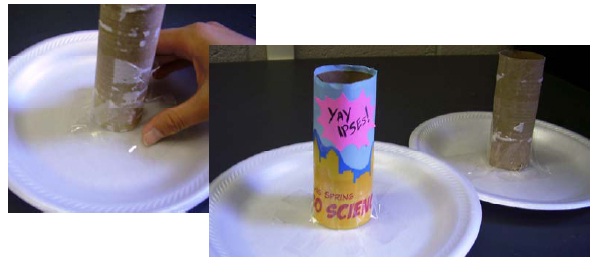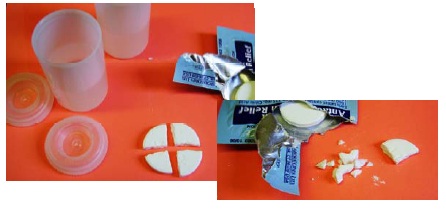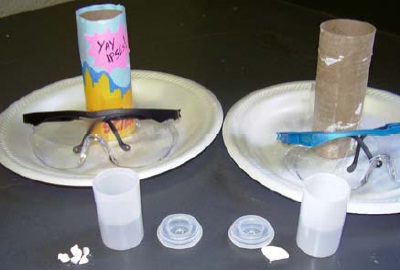





Published on Apr 02, 2024
The smaller a particle is, the greater its surface area to volume ratio. This ratio describes how much area of the particle is in contact with the outside compared to how much “stuff” is within the particle. This activity explores how changing particle size affects the rate of a chemical reaction. Using water and effervescent sodium bi-carbonate tablets, you will build film canister rockets that propel themselves! This activity is linked to the Antibacterial Silver demonstration that you may have seen at the Small Wonders cart at a science museum.
• Explore the how changing the physical characteristics of a material changes how it interacts with other materials.
• Learn how the surface-area-to-volume ratio changes with particle size.
• Alka-seltzer tablets
• A friend!
• 2 Disposable plates
• Tape (packaging tapeworks best)
• A stop-watch (optional)
• Eye protection
• 2 Film canisters (Fuji film works well)
• 2 Cardboard tubes from bathroom tissue rolls
• Measuring tape (optional)
• The first step is to build your rocket launchers using the cardboard tubes and disposable plates.
• Center each cardboard tube on a plate and secure it using the packing tape. If you like, you can decorate your rocket launchers.
• The next step is to prepare the Alka-seltzer tablets to be used as fuel in your rocket.

• Have your parent help you cut or snap the tablet into four equal pieces; you will only need two of these pieces for the activity.
• Measure equal amounts of water into each empty film canister so that it is about ½ way filled. It’s important to keep the amount of water equal in each film canister so that your results are not affected.
• Between you and your friend, decide who will crumble up their rocket fuel into smaller pieces and who will use the piece of tablet as it is. DO NOT ADD THE ALKA-SELTZER TABLETS TO THE CANISTERS YET! That will be a later step.

• Clear your area for the rocket launch. This means that you need to be wearing your eye protection, that you are not shooting the rockets at or near any other person, and that you have all your supplies ready: your cardboard launcher, your Alka-seltzer fuel, your film canister ½ filled with water, and the cap to the canister.
• Now you are ready to launch your rockets! Try to guess which rocket will launch faster: the person with one big piece of fuel, or the person with the same amount of fuel, but crumpled into smaller pieces?
• The last few steps are the most complicated because they must be done very quickly; read through the rest of the instructions BEFORE you start this step. You and your friend need to put your Alka-seltzer tablets into the film canisters at the same time.
• Quickly cap the film canisters and insert them into the launchers cap-side down.

• Aim the two launchers away from yourselves and away from anyone else and wait for your rockets to launch! Be patient! This step takes up to 1 minute.
• DO NOT LOOK DOWN THE LAUNCHER TO CHECK ON YOUR ROCKET!!! If after several minutes your rocket doesn’t detonate, tilt the launcher away from your face and slide the film canister out onto the floor. Hold the canister in your hands with the cap facing away from your face and pop it off with your thumbs. Then, try the activity again using 1/3 of an Alka-seltzer tablet.
• Whose rocket launched first?
When the Alka-seltzer is added to the water, the tablet dissolves into the water and in the process produces a gas called carbon dioxide. When you cap the film canister with the Alka-seltzer and water inside, the gas that is produced becomes trapped. As more and more gas is produced and is trapped, pressure within the film canister begins to build. Eventually, the pressure is so great that the force of the gas pops open the film canister. There is so much force that when the cap pops off, the film canister is shot up into the air! The rocket that used the crumpled Alka-seltzer as fuel should have launched first. Although both rockets used the same amount of water and Alka-seltzer, the fuel in this rocket had a greater surface-area-to-volume ratio. Since the gas-producing reaction can only occur on the surface of the tablet, this increased ratio means that more gas was produced more quickly and so the pressure increased faster than in the large-piece rocket.
• Try changing the amount or temperature of the water that you use; does it make a difference in how fast the rocket will launch? What about the distance the rocket travels?
• What if you vary the angle when you shoot the rocket? What’s the best position to hold the launcher so that the rocket travels the farthest distance
In this activity, you explored how changing the particle size of a reactant affected how it behaved in a reaction. Although you used the same amount of Alka-seltzer, by changing its physical form you affected its rate of reaction with water. This caused pressure within the film canister to build more quickly and the rocket to launch faster. In products like the antibacterial silver food storage containers that you saw at the museum, changing the particle size of the imbedded silver affects its ability to react. Nanosilver particles are so tiny that their surface area to volume ratio is very high, making them extremely effective at preventing bacteria growth. The importance of a high surface-area-tovolume ratio is not just important for nano-silver; it is a fundamental principal of nanoscience and biological cells!
1. Alka-Seltzer. (2009). Student Science Experiments., from http://www.alkaseltzer.com/as/student_experiment.html Institute of Physics. (2009).
2. Alka-seltzer Rocket., from http://www.physics.org/interact/physics-to-go/alka-seltzer-rocket/index.html
3. Math is Fun! (2000). Math Definitions., retrieved May 10, 2009, from http://www.mathsisfun.com/definitions/index.html